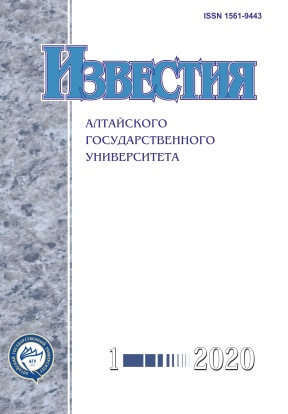Microwave Satellite Systems for Hydrological Monitoring
УДК 537.86:556+528.85
Abstract
This paper considers existing and promising satellite microwave radiometry systems suitable for the evaluation of geophysical (hydrological) parameters of atmosphere, ocean, and land. A comparative analysis is provided for data sets available for end-users. Algorithms and tools for processing and visualization of satellite data are discussed. The capabilities of modern satellite systems to perform specific tasks of remote sensing are described using the example of a river flood in the Altai region in 2014. Monitoring soil moisture of upper layers of soil on floodplains combined with meteorological forecasts allows assessment of the probability of river flooding at certain areas using values of maximum soil moisture capacity. The effect of changes in the physical properties of ice during its destruction is discussed. This effect has been discovered by analyzing the dynamics of daily satellite measurements of brightness temperatures. It can be considered as a harbinger of ice condition changes of large freshwater bodies. The analysis of brightness temperature seasonal variations is presented using the example of Lake Big Bear (Canada).
Downloads
Metrics
References
Stampoulis D., Andreadis K.M., Granger S.L., et al. Assessing hydro-ecological vulnerability using microwave radiometric measurements // Remote Sensing of Environment. 2016. Vol. 184. D01:10.1016/j.rse.2016.06.007.
Lorenz C., Montzka C., Jagdhuber T., et al. LongTerm and High-Resolution Global Time Series of Brightness Temperature from Copula-Based Fusion of SMAP Enhanced and SMOS Data // Remote Sensing. 2018. Vol. 10 № 11. DOI: 10.3390/rs10111842.
Tikhonov V.V., Boyarskii D.A., Sharkov E.A. et al. Microwave Model of Radiation from the Multilayer “Ocean-atmosphere” System for Remote Sensing Studies of the Polar Regions // Progress in Electromagnetics Research B. 2014. Vol. 59. DOI: 10.2528/PIERB14021706.
Данилычев М.В., Кутуза Б.Г. Современные спутниковые радиометры микроволнового диапазона // VI Всероссийские Армандовские чтения. Муром, 2016.
Митник Л.М., Митник М.Л., Заболотских Е.В. Спутник Японии GCOM-W1: моделирование, калибровка и первые результаты восстановления параметров океана и атмосферы // Современные проблемы дистанционного зондирования Земли из космоса. 2013. Т. 10. № 3.
Maeda T., Kazumori M., Aonashi K., et al. Descriptions of GCOM-W1 AMSR2 Level 1R and Level 2 Algorithms. NDX-120015A // Japan Aerospace Exploration Agency. 2013.
Gaiser P.W., Germain P.W., Twarog E.M. et al. The WindSat Spaceborne Polarimetric Microwave Radiometer: Sensor Description and Early Orbit Performance // IEEE TGRS. 2004. Vol. 42. № 11. DOI:10.1109/TGRS.2004.836867.
Hilburn K.A., Meissner T., Wentz F.J., et al. Ocean Vector Winds From WindSat Two-Look Polarimetric Radiances // IEEE TGRS. 2016. Vol. 54. № 2. DOI: 10.1109/ TGRS.2015.2469633.
Zhang L., Yin X., Shi H., et al. Hurricane Wind Speed Estimation Using WindSat 6 and 10 GHz Brightness Temperatures // Remote sensing. Vol. 8. № 9. DOI: 10.3390/rs8090721.
Gutierrez, A., Castro, R., and Vieira P.: SMOS L1 Processor L1c Data Processing Model, DEIMOS Engenharia, Lisboa, Portugal. 2014
Ященко A.C., Бобров П.П. Особенности обработки данных SMOS Level 1С в задачах дистанционного зондирования // Современные проблемы дистанционного зондирования Земли из космоса. 2017. Т. 14. № 3. DOI: 10.21046/2070-7401-2017-14-3-78-91
Sahr, K., White, D., and Kimerling, A. J. Geodesic Discrete Global Grid System // Cartography and Geographic Information Science. 2003. V. 30. № 2.
Romanov A.N., Khvostov I.V. Microwave Remote Monitoring of Altai Catastrophic Flood Dynamics Using SMOS Data // IEEE Geoscience and Remote Sensing Letters. 2015. Vol. 12. № 10. DOI: 10.1109/LGRS.2015.2444592.
Хвостов И.В., Романов А.Н., Тихонов В.В. и др. Некоторые особенности микроволнового радиотеплового излучения пресноводных водоемов с ледовым покровом // Современные проблемы дистанционного зондирования Земли из космоса. 2017. Т. 14. № 4. DOI: 10.21046/20707401-2017-14-4-149-154.
Tikhonov V., Khvostov I., Romanov A., et al. Theoretical study of ice cover phenology at large freshwater lakes based on SMOS MIRAS data // The Cryosphere. 2018. Vol. 12. DOI: 10.5194/tc-12-2727-2018.
Izvestiya of Altai State University is a golden publisher, as we allow self-archiving, but most importantly we are fully transparent about your rights.
Authors may present and discuss their findings ahead of publication: at biological or scientific conferences, on preprint servers, in public databases, and in blogs, wikis, tweets, and other informal communication channels.
Izvestiya of Altai State University allows authors to deposit manuscripts (currently under review or those for intended submission to Izvestiya of Altai State University) in non-commercial, pre-print servers such as ArXiv.
Authors who publish with this journal agree to the following terms:
- Authors retain copyright and grant the journal right of first publication with the work simultaneously licensed under a Creative Commons Attribution License (CC BY 4.0) that allows others to share the work with an acknowledgement of the work's authorship and initial publication in this journal.
- Authors are able to enter into separate, additional contractual arrangements for the non-exclusive distribution of the journal's published version of the work (e.g., post it to an institutional repository or publish it in a book), with an acknowledgement of its initial publication in this journal.
- Authors are permitted and encouraged to post their work online (e.g., in institutional repositories or on their website) prior to and during the submission process, as it can lead to productive exchanges, as well as earlier and greater citation of published work (See The Effect of Open Access).








